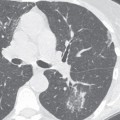CASE 52 61-year-old woman with long-standing history of alcohol abuse presented with sudden onset of cough, pleuritic chest pain, dyspnea, fever, and rigors PA (Fig. 52.1A) and lateral (Fig. 52.1B) chest radiographs reveal a homogeneous, nonsegmental air space consolidation localized to the superior segment left lower lobe. No air bronchograms are seen. The affected lobe is overexpanded, and the oblique fissure bulges anteriorly and superiorly (bulging fissure sign) (Fig. 52.1B). Contrast-enhanced axial (Fig. 52.1C, mediastinal window; Fig. 52.1D, lung window) and accompanying sagittal (Fig. 52.1E, mediastinal window; Fig. 52.1F, lung window) chest CT shows the relationship between air space consolidation and the oblique fissure. Note the outward displacement of the cephalad aspect of the fissure (compare Fig. 52.1B and Fig. 52.1F). The superior segment is densely consolidated. The low-attenuation areas represent foci of necrosis. Enhancing blood vessels can be seen in the areas of low-attenuation consolidated lung parenchyma (CT angiogram sign). Also note the background of extensive centrilobular emphysema. Klebsiella Pneumonia (aka Friedländer’s pneumonia) • Pneumococcal Pneumonia • Mixed Anaerobic Infection • Haemophilus influenza Pneumonia • Staphylococcal Pneumonia Klebsiellae are ubiquitous in nature. In humans, they may colonize the skin, pharynx, gastrointestinal tract, sterile wounds, and urine and are regarded as normal flora in many parts of the gastrointestinal and biliary tracts. Oropharyngeal carriage is associated with endotracheal intubation, impaired host defenses, and antimicrobial use. The primary pathogenic reservoirs are the gastrointestinal tract of patients and hands of hospital personnel, the latter often responsible for nosocomial outbreaks. Klebsiella pneumonia usually results from aspiration of colonizing oropharyngeal microbes into the lower respiratory tract. Risk factors for Klebsiella pneumonia include alcoholism, diabetes mellitus, and COPD. Klebsiella pneumonia is caused by the Gram-negative bacterium Klebsiella pneumoniae. K. pneumoniae causes approximately 5% of community-acquired pneumonia and up to 30% of nosocomial pneumonia. The extensive clinical use of broad-spectrum antibiotics in hospitalized patients has led to increased carriage of Klebsiella as well as the evolution of multi-drug-resistant strains (MDRS). Lung infection by K. pneumoniae
 Clinical Presentation
Clinical Presentation
 Radiologic Findings
Radiologic Findings
 Diagnosis
Diagnosis
 Differential Diagnosis
Differential Diagnosis
 Discussion
Discussion
Background
Etiology
![]()
Stay updated, free articles. Join our Telegram channel

Full access? Get Clinical Tree





